Analyzing Intel Core M Performance: How 5Y10 can beat 5Y71 & the OEMs' Dilemma
by Brett Howse & Ian Cutress on April 8, 2015 8:00 AM EST3DMark Cloud Gate Results
3DMark Cloud Gate is a benchmark aimed at notebooks and home PCs, and is quite a bit less demanding. It has a DirectX 11 engine but is limited to Direct3D feature level 10, and is compatible with DirectX 10 hardware. The overall run is about three minutes.
There is not much more to be said about the Core i5 at this point. It does an admirable job keeping the GPU frequency almost flat during this benchmark. You can clearly see the Dell Venue 11 Pro ramping up frequencies on the CPU, which cause temperature spikes when this happens. When it throttles the CPU on this workload, it does free up enough thermal room to allow the GPU frequency to be fairly strong. We see a lot of throttling on the ASUS as well, but not quite as pronounced. Once again, on the physics test the GPU is pushed down in frequency to give the CPU more room. The Yoga 3 Pro tries its best but is once again limited by a much lower SoC temperature set point.
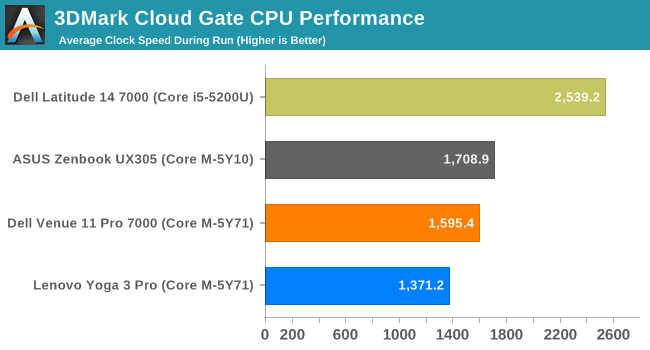
On the CPU side, we have a very similar situation to the Sky Diver benchmark. The ASUS once again keeps a higher average CPU frequency than all of the other Core M devices in this test. The Venue 11 is close though.
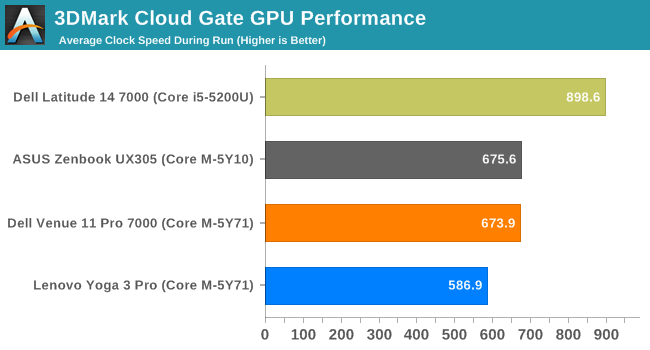
On the GPU side, the Zenbook and Venue 11 Pro are basically tied. The shorter and less demanding workload lets the Dell keep up despite not having as good of a cooling solution. But, averages are just averages. Clearly the ASUS keeps a substantially higher GPU frequency for much of this test, as is seen in the graph.

The SoC temperatures are actually quite high on the Zenbook in this test, with it coming close to the Venue 11 Pro, but the cooling system clearly is more efficient since the change in temperature on the ASUS is much more gradual than the spikes seen in the Venue 11 Pro. The Yoga 3 Pro tries to stay around 65°C but near the end the temperature does go above their target.
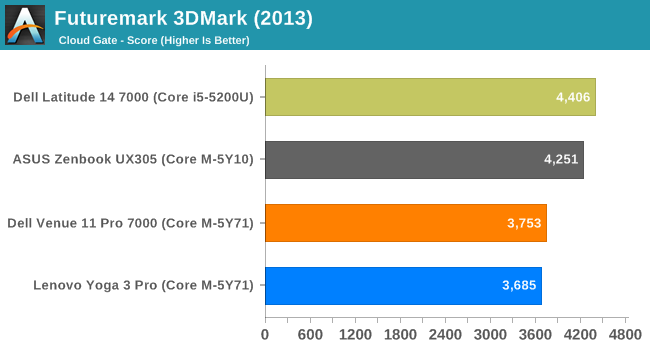
The overall benchmark results for this test are very similar to the previous 3DMark test. The ASUS comes in very close to the Dell Latitude with its Core i5, and the other devices fall back quite a ways. Long sustained GPU workloads are very difficult for both of the 5Y71 devices to handle.


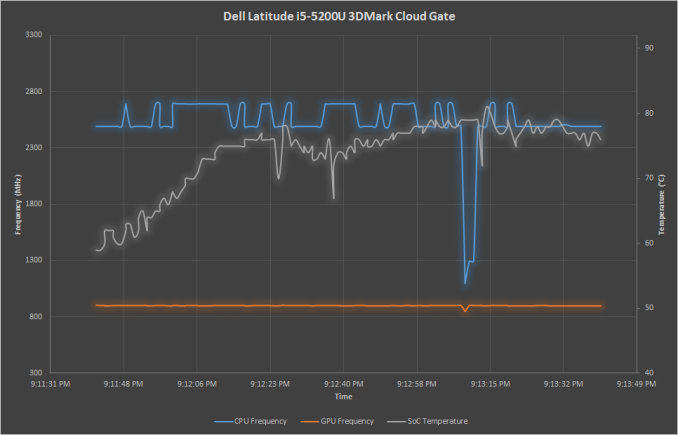
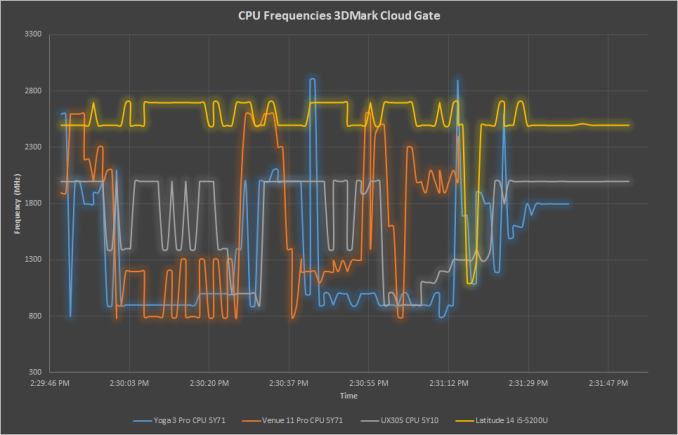
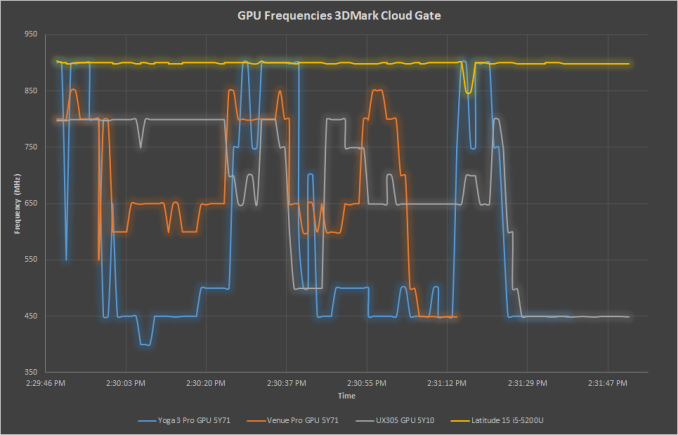
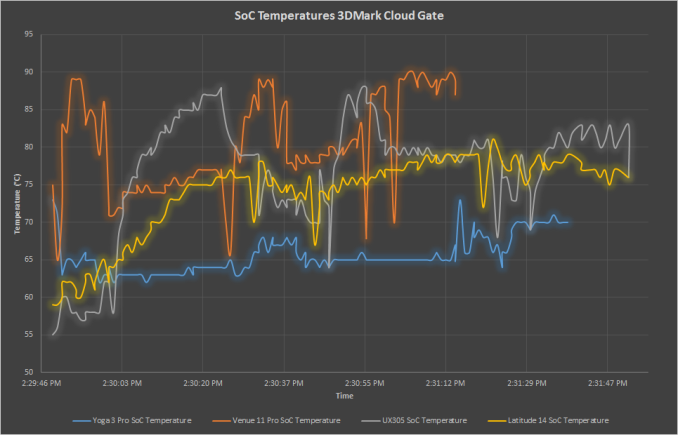








110 Comments
View All Comments
jjj - Wednesday, April 8, 2015 - link
You insist on only showing low power CPU results , because putting them properly in context would hurt sales right? God forbid you include laptops....And today somehow you decided to fully ignore AMD too.
Maybe stop working for Intel and serve your readers instead.
MrSpadge - Wednesday, April 8, 2015 - link
Dude.. WTF?This is an evaluation of what Core M is and what this means for devices using it. It's neither a comparison to other device and CPU classes, nor a general recommendation of this product.
Michael Bay - Wednesday, April 8, 2015 - link
AMD just can`t afford a decent shill anymore.THIS is what they go these days.
xthetenth - Wednesday, April 8, 2015 - link
I guess it's easy to confuse discussions of architectural details for devices that have already been reviewed on this very site with articles comparing those devices to other similar devices when the preexisting reviews contain many of the very comparisons you want.Dorek - Wednesday, April 8, 2015 - link
"And today somehow you decided to fully ignore AMD too."Only because the market does.
Refuge - Wednesday, April 8, 2015 - link
This article was never about comparing the CPU's to AMD or anyone. It was about explaining why we are getting awkward results across the board on the performance of these low TDP Intel parts.Nothing to do with AMD, or even the specific OEM's products either, so much as their construction and heat dissipation performance, but it was only in an effort to further explain the varying results of these low TDP Intel chips.
Pissedoffyouth - Wednesday, April 8, 2015 - link
Haha how does a 4.5w CPU for a laptop have anything to do with a 65w+ desktop CPU?Allan_Hundeboll - Wednesday, April 8, 2015 - link
If he was working for intel he would have included amd's "lowpower" cpuname99 - Wednesday, April 8, 2015 - link
Yeah, it's ridiculous.Why isn't there also a comparison against a POWER8 --- that would DEMOLISH this silly little Broadwell-Y.
And they're going on about how great the power dissipation is? Compare it against an ARM M0 and look who has crazy low power dissipation then!
I demand that every future AnandTech review compare any CPU against every other other CPU in the known universe, no matter how irrelevant the comparison...
lilmoe - Wednesday, April 8, 2015 - link
That price tag makes this the most confusing and out-of-place processor from Intel... Microsoft proved that Haswell-U can power an ultra-thin x86 tablet, have mobile SoC comparable battery life, and price it comparably or even lower than Core M products. All that with the added benefit of better performance...OEMs can take advantage of lower pricing on some Broadwell-U processors, and install a better/thinner active cooling solution with the savings. So where does that put Core M other than "luxury" devices that have no need for "real" performance advantages?
Not for me, thanks... Not at THAT price tag.